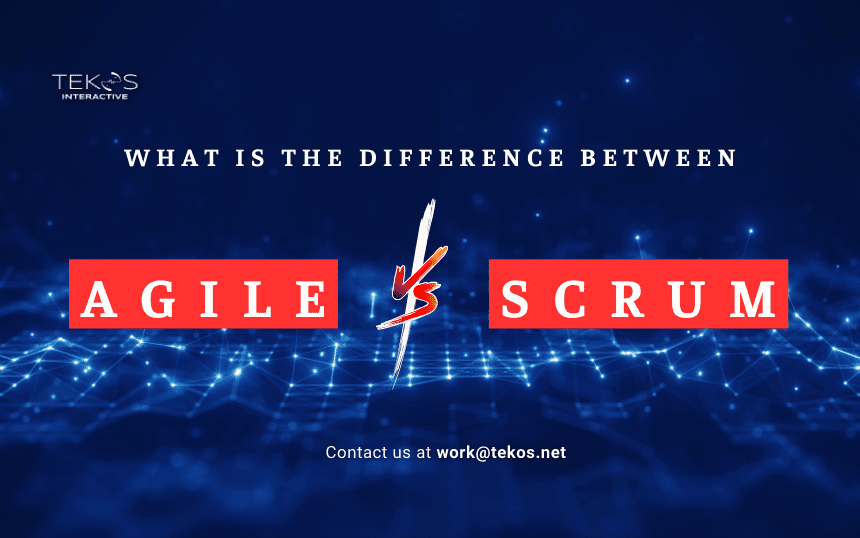There are some people who think “Agile” and “Scrum” are the same. In daily life, we often confuse and use these terms interchangeably because both involve a flexible focus on continuous improvement in software development. However, they are two distinct concepts. So What is Agile really like? what is the difference between Agile and Scrum?
Indeed, we can’t be truly “agile” in the blink of an eye about creating and delivering value to our customers, especially in the IT industry. But we can apply a framework like Scrum to help start thinking and practice building agile principles in our daily communication and work on projects.
What is Agile?
Agile is basically a project management philosophy that prioritizes collaboration, flexibility, and customer satisfaction. It is based on the Agile Manifesto, a set of 4 values and 12 principles for software development that highlights:
- Individuals and interactions over tools and processes.
- Working software over comprehensive documentation.
- Customer collaboration over contract negotiation.
- Response to change over following a plan.
Adopting an Agile methodology gives us a new perspective on the core values that we truly seek when working on a project and is usually the favored choice by many organizations, not only in the IT area but in most fields. There are positive results verified over 20 years since its creation for the following reasons :
- Collaboration: Agile encourages collaboration between development team members, as well as between the development team and the customer, leading to better-quality software and increased productivity.
- Flexibility: Agile allows for changes and adjustments to be made throughout the development process, leading to a more flexible and adaptable final product.
- Better Quality: Agile emphasizes continuous testing and improvement, which leads to a higher-quality product that meets customer requirements.
- Faster Delivery: Agile emphasizes delivering working software as soon as possible and then continuously improving upon it. This leads to faster delivery of the final product and a quicker return on investment.
- Customer Satisfaction: Agile prioritizes customer satisfaction and encourages direct communication between the development team and the customer, ensuring that the final product meets the customer’s needs.
Examples of Agile frameworks
Several Agile frameworks were created based on the aforementioned values, to guide organizations’ software development process. Some of the most well-known Agile frameworks are :
- Scrum
- Kanban
- Extreme Programming (XP)
- Lean
- Crystal
- Feature-Driven Development (FDD)
- Dynamic Systems Development Method (DSDM)
They aren’t all frameworks existing in the agile methodology, Agile itself is not limited to any specific set of practices or tools, new ones are still evolving and shaping by innovating and blending Agile practices to create the unique approach that best fits some specific needs.
How is Scrum different from Agile?
On the other hand, Scrum is a specific framework within the Agile methodology based on empiricism and lean thinking. Scrum is the Agile method we most commonly use in practice (applied across many industries and companies. See source: Who uses Scrum) because of its practical application (ie: Why uses Scrum).
Scrum combines a set of processes and rules that build the structure toward Agile development and help teams work together effectively and naturally to deliver high-quality software.
In fact, Scrum provides a step-by-step approach for managing and handling complex projects in complex environments. We can then break work down into smaller, manageable units and regularly reassessing and adjusting plans as needed. Scrum revolves around continuous incremental improvement, through small and frequent release cycles. This allows the Scrum team to constantly learn, adapt and improve.
So scrum is a lightweight framework, it always adheres to the following beneficial characteristics: adaptive, fast, flexible, incremental, and iterative.
It allows us to deliver small increments of the software product after iterations, get quick feedback from stakeholders, to adapt to the actual needs of customers and increase project’s success’ level. Last but not least, Scrum contributes to the control and good use of the budget, time, and resources in each stage of product implementation. These are the core values of the Agile approach.
Conclusions
In summary, Agile is a philosophy and Scrum is one of its specific implementation. It has its own defined set of practices and rules. While Agile can be applied to any type of project, Scrum is specifically designed for software development. One can say that Scrum is a part of Agile and plays an important and valuable role in practice.
We use a lot of these terms when implementing different projects, especially in the IT field. With a clear and basic view, the more we understand them, the more proficiently and effectively we will use them. But the question is: after more than 20 years since the creation of the Agile Manifesto, should we still consider it to be a guideline for most development projects? Do we have a better methodology at hand that can replace it in this modern world that never stops innovating?
Would you like to read more articles by Tekos’s Team? Everything’s here.
References
– The benefits and advantages of Agile: https://www.wrike.com/agile-guide/benefits-of-agile/
– Is the Agile Manifesto still a thing? : https://www.atlassian.com/agile/manifesto
– 12 principles behind the Agile Manifesto: https://agilemanifesto.org/principles.html
– Book: Scrum Guide, version 2020, by Ken Schwaber & Jeff Sutherland
– Courses on Udemy: Agile – Scrum – Kanban

